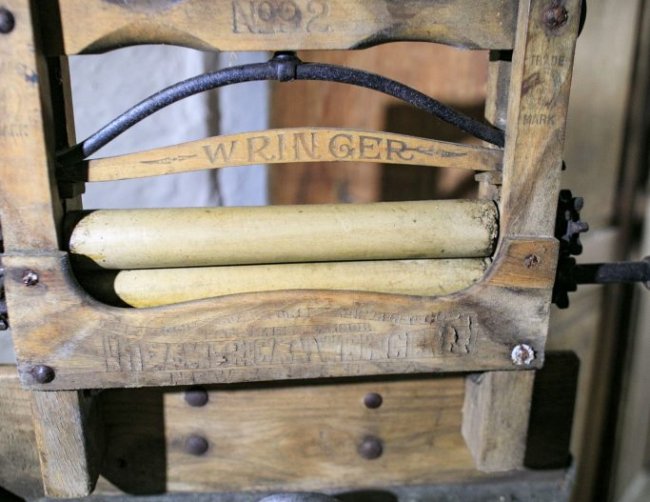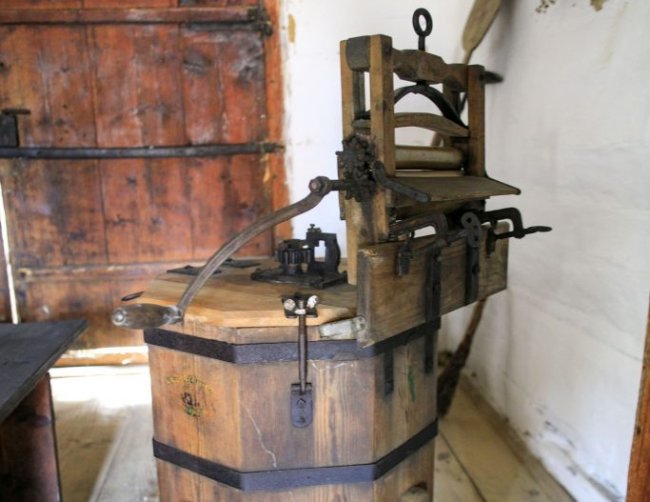Object
Wooden washing machine
Information
Inventory no
MP
Department
Ethnography Department
Material
wood, metal
Copyright classification
https://pl.wikipedia.org/wiki/Domena_publiczna
Description
In the hall of a wealthy highlander's house from Zagorzyn in the Sądecki Ethnographic Park, looking at the center of the spores of a wooden device. It consists of an octagonal container made of vertical boards joined with metal hoops, supported on four wooden, slightly bent legs. Inside there is a corrugated wooden stand with two handles for removal, supported by a metal bar.
A similar corrugated element is attached to the underside of the lid. On top of the lid there is a metal mechanism, incomplete - there is no lever, crank or other device that sets the whole thing in motion. In the upper part, on the side, there is a board to which a wooden factory wringer with two rubberized rollers moved by a crank is attached. The latter item indicates the purpose of the entire device - it is a washing machine. The working mechanism in the washing machine are those two corrugated wooden plates, one of which was movable - during the operation of the mechanism and under the influence of water, dirt was removed. This type of washing machines were known from the 1840s and were used until the end of the interwar period, and sometimes even longer. Models produced in the 20th century were even equipped with electric motors.
The first prototypes of washing machines appeared in the 18th century - they were vats into which clothes or underwear were put and set in motion with a crank. Then, at the end of the 18th century, the tare was invented, which facilitated simple hand washing. The first drum washing machine was created in 1851 - its creator was the American inventor James King, and the washing machine had a steam drive. Over the next 20-30 years, many patents were issued for various types of washing machines. The first washing machine with an electric device was produced in 1899, however washing machines operated in this way were introduced in the 20th century. At the beginning of the twentieth century was used for washing in addition to soap preservation. These were, for example: concentrated beef bile (effective against grease and dirt, but due to its own dye - only for dark fabrics), soap root (native plant) and quillaya (bark from a South American tree) - for woolen and red things, borax – for lace, curtains and table linen, salamic acid and turpentine, bran (for washing silk), raw grated potatoes (for colored cotton fabrics), chloride for bleach and gasoline as an agent for fats. The first powders for processing already before the first world rate, and in a simple way they start to be used only after the Second World War. In 1937, the first automatic washing machine was created, this technology was developed after World War II. the first Polish medical washing machine - Polar PS 663 Bio - was produced in 1971. Its subsequent versions were popular in Poland in the 1970s and 1980s. Gradual displacement of the rotor washing machines, the most famous of which was "Frania".
Nowadays, it is difficult for us to imagine life without such a useful device as a washing machine. Sometimes we wash by hand, but this only applies to selected, delicate items. We also have a large selection of various washing agents, from traditional soap, through various types of detergents, to environmentally friendly agents based on natural substances, which have recently become more and more popular. What was it like in the countryside in the past? Washing machines of the type presented in the cottage from Zagorzyn were a rarity, available only to the wealthiest hosts, and only in the 20th century. The level of hygiene was not very high, but as far as possible, efforts were made to take care of the cleanliness and appearance of clothing, especially the festive one. That is why virtually every household had washing, mangling and ironing equipment. Woolen clothes and sheepskin coats were not washed, they were only aired and beaten in the snow in winter. Products made of homespun linen fabrics were leached and washed. Leaching was carried out in tall stave vessels, the so-called zolniki - underwear was poured with hot lye made of wood ash boiled in water. The lye has a strong cleaning and fat-dissolving effect and is also used in the production of soap. Sometimes the ashes in the bag were placed on the last layer of underwear and poured over with boiling water, which turned into lye upon contact with the ashes. Only the next day, after leaching, clothes and underwear were taken to a stream, river or pond - for washing with tadpoles - boards with handles, which were struck against the fabric. Soap was also used for washing, sometimes homemade (made of animal fat and lye or soda), later bought. Sometimes the leached garments were soaped and boiled in large pots in the kitchen. Homespun linen fabrics held up well to leaching and beating with tadpoles. On the other hand, factory-made cotton fabrics, over time more and more popular in the countryside, treated in this way deteriorated very quickly. Therefore, wooden stave tubs (later made of metal) and special tars - made of wood, later of galvanized sheet, and sometimes even of glass or ceramic, as well as commercial gray soap and bleaching chloride, began to be used for washing. Linen fabric after washing and drying was stiff and rough - so a mangle with a roller was used to soften and smooth it. The fabric was wound on a roller, and then the mangle (a notched board) was moved over the roller, back and forth, pressing hard, then the roller rotated. The fabric should be slightly damp during this operation (as when ironing in a mangle). Delicate materials were pressed using irons - most often coal or soul (a hot piece of cast iron put inside). Even now, washing and ironing, especially the larger ones, requires some effort, while the old washing equipment gathered at the exhibition of the open-air museum reminds us how hard, laborious and time-consuming it was in times when no one in the countryside even dreamed of electricity and automatic washing machines.
Boguslaw Blazewicz
Major literature:
Tomasz Czerwiński, "Equipping a country house in Poland", Warsaw 2009
Maria Ochorowicz-Monatowa, "Women's household in the city and in the countryside", Warsaw - Lviv 1914


